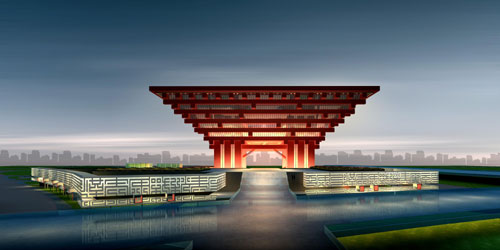|

The China National Pavilion will showcase the wisdom of the Chinese people in urban construction from ancient times to the future in a three-story building, according to the design team for the China Pavilion at the 2010 Shanghai World Expo.
“High-quality design is required for the display,” said chief designer Pan Gongkai. “There are some 200 national pavilions at the Expo, and each want to show their best. The China National Pavilion is both the largest and the highest one, so it must show extra effort.”
“Designers will make use of artistic devices to create a fancy space and multimedia projection to express their design notion,” said Chen Xianjin, Deputy Director General of the Shanghai World Expo Coordination Bureau. “For a host country, displays at the national pavilion should be fun, look good and embody the country’s culture, so as to leave a deep impression on visitors.”
The design team disclosed the China Pavilion’s interior display plan at a press conference on August 20. The exhibits are arranged separately on three floors with three themes--Footprint of the East, Journey of Wisdom and Blossoming City. They represent the development of China’s urbanization, the country’s traditional architecture, and its energy thrift and environmentally friendly future construction.
Footprint of the East is the main part of the display, located on the 49-meter-high top floor and covering 8,500 square meters. At the center of the floor, visitors will see an eight-minute film made by Lu Chuan, who is known for his films Kekexili: Mountain Patrol and City of Life and Death (Nanjing, Nanjing in Chinese). The film will be shown in a 700-seat theater.
“The film will use a poetic style to unfold China’s unprecedented process of urbanization, changes in urban construction over the past 30 years, and the zest of the Chinese people for urban construction and their triumphant faith in the future,” Lu Chuan said.
A 100-meter version of the panoramic painting Along the River During the Qingming Festival will be screened on the north wall of the top floor. The painting, known as a treasure in China, can be traced back more than 1,000 years. It displays a scene in the prosperous city of Bianjing, now known as Kaifeng in central China’s Henan Province. Modern multimedia technology will enable the more than 1,500 characters in the painting to walk and move.
The original painting has at least six versions, including those stored separately in both the Chinese mainland and Taiwan. The one at the Palace Museum in Beijing is very likely to be displayed at some point in the China Pavilion, and organizers hope other versions will be displayed during the Expo.
Journey of Wisdom is on the 41-meter-high second floor and covers an area of 3,500 square meters. Visitors will enter a dream-like hall with a green background, accompanied by a projector screen that shows how people living in new and old cities are enjoying a harmonious life together. It embodies the notion of harmonious integration between rural and urban areas.
A cable car will take visitors on a 10-minute trip along an elevated zigzag rail. From the cable car, visitors can see examples of traditional Chinese courtyards, houses made of bricks and tiles, gardens and stone bridges south of the Yangtze River, and several wooden structures, which are a special feature in China’s traditional construction.
The hall will also exhibit treasured relics related to China’s four great inventions--the compass, paper, printing and gunpowder, according to Pan Gongkai, who is also the President of the China Central Academy of Fine Arts.
Blossoming City is on the 33-meter-high ground floor and covers an area of 3,400 square meters. It will show visitors how the Chinese people are using their wisdom and ingenuity to address future challenges in urbanization. Technologies that reduce carbon dioxide emissions and encourage non-polluting new energies will be on display, providing Chinese-style solutions for future development.
For the sake of convenience, the ground floor is simply designed, with white as a basic background color. The streamlined design and the changeable lights and projector screens create a versatile space for people to imagine a hopeful future.
“Water will go through all three stories,” said Yao Kai-yang, creative director of the pavilion and creative director of Taiwan YAOX Edutainment Co. “There are real water and virtual water effects made by multimedia technologies.”
It will take visitors 45 minutes to visit the whole three-story pavilion. Each of the four pillars will have an elevator, because even the lowest exhibition hall is as high as a 10-story building.
Organizers expect up to 50,000 visitors a day. To avoid long queues, visitors are required to make reservations in advance. Organizers are considering extending the exhibition after the Expo ends, so as to let more people visit the China Pavilion.
Upon completion of the building by the end of September, interior work will begin in October and final inspections will be conducted next March, the Expo organizers said.
(Source: Oriental Morning Post and expo2010.cn, edited by LI YUZHU) | 